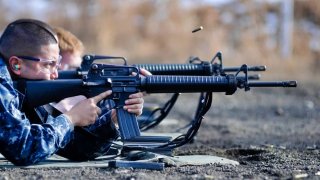Legacy of the M16 Rifle in the Vietnam War
The basic weapon system, in its highly compact M4 variant, remains in service with the U.S. military today, with a superb reputation for reliability and durability. But the stigma of the early M16’s unreliability still lingers in the minds of many after all these decades.
Fifty years after its official end, the Vietnam War remains one of the most tragic, controversial, and divisive wars in American history (though both the Iraq War and Afghanistan War certainly give it a run for the money). Among other things is that it was the first war that the United States of America lost, although we actually came a lot closer to winning the damn thing than most mainstream media and ivory tower academic pundits are willing to admit.
Besides the geopolitical controversies generated by the Vietnam War, it also spawned the career of what is arguably the most controversial rifle ever issued to the U.S. Armed Forces: the 5.56mm/.223 Remington caliber M16 rifle, AKA the “Mattel.” I first read this slang term for the weapon in the novel The Short-Timers by Gustav Hasford, which in turn served as the basis for the screenplay of Stanley Kubrick’s cinematic masterpiece Full Metal Jacket. It is also known as the “Black Rifle” and the “Plastic Fantastic.”
Where It Began
The M16’s predecessor in U.S. military service, the 7.62x51mm NATO (.308 caliber) M14, had become the standard-issue rifle back in 1959, except for the U.S. Air Force Air Police/Security Police (nowadays known as Security Forces), who stuck with the M1/M2 .30 carbine for the time being. The M14 was rugged, reliable, accurate, and powerful but was also plagued by perceived problems for infantry usage in the jungles of Vietnam: the heavy weight and lack of controllability during full-auto fire. Plus, the long-distance dialing (so to speak) capabilities of the M14 were deemed mostly unnecessary in those Vietnam jungles. In short, it was overkill.
Meanwhile, the .30 carbine was dependable, lightweight, and user-friendly on the one hand—a “hoot to shoot,” to quote Guns Magazine reporter Mike “Duke” Venturino—but on the other hand, had developed a reputation for poor stopping power during World War II and the Korean War.
In theory, the M16 rifle could have solved all of these shortcomings. Compared with the M14, the M16 carried more rounds in a more lightweight and lower-recoiling platform—6.37 lbs. (2.89 kg) vs. 9.2 lbs. (4.17 kg)—ergo more bang for the buck.
Meanwhile, vis-a-vis the M1/M2 .30 carbine, the M16’s 5.56x45mm NATO/.223 Remington round offered superior terminal ballistics whilst still remaining lightweight and offering a high magazine capacity (30 rounds) to boot.
It was actually the “kinder, gentler” U.S. Air Force (USAF) that became the first branch of service to adopt the M16 as a standard-issue rifle in 1963. This occurred just three years after the weapon had left a positive impression on the legendary USAF Chief of Staff Gen. Curtis E. LeMay; for those of you familiar with LeMay’s story, you know that he was a hard-ass who wasn’t easily impressed. The U.S. Army Special Forces followed suit shortly thereafter. Meanwhile, Lt. Cdr. Roy Henry Boehm, “The Godfather of the Navy SEALs,” lobbied heavily for the weapon to be issued to his sailors.
By contrast, the conventional Army and the Marine Corps were slower to embrace the M16 but came around soon enough. The Army started making the “Black Rifle” standard issue in 1965. And during that same year, the rifle saw its major combat usage by conventional forces, at the Battle of Ia Drang, which was immortalized in both the bestselling book We Were Soldiers Once… and Young, by Lt. Gen. Harold G. “Hal” Moore and war correspondent Joseph L. Galloway, and the filmic adaptation—retitled simply We Were Soldiers—starring Mel Gibson, Sam Elliott, and Barry Pepper (best known as the sniper in Saving Private Ryan).
Moore explicitly credited the weapon as being a determining factor in how his unit was able to survive and triumph in the battle. Meanwhile, Special Forces troops’ initial after-action reports on the rifle’s performance were highly commendatory.
Okay, So What Went Wrong?
By the end of 1965, a proverbial tidal wave of reports of severe stoppages and gross malfunctions of the M16 had begun flooding in. The most frequently recurring stoppage was failure to extract fired cartridge cases, typically attributable to a heavily carbonized and rust-pitted chamber. News reporters caught wind of these horror stories, and soon the American public became justifiably outraged over stories of GIs dying in the literal and figurative muck because of hopelessly jammed rifles.
As to the causes of the epidemic of deadly malfunctions, to make a long story short, David Lane of PewPew Tactical boils it down to two main culprits: (1) The U.S. Army willfully used the wrong powder in its ammunition, and (2) the chamber and bore of the barrels were not chrome plated.
The M16 Rifle Series Today (In Brief)
Several years and after thousands of Americans had been killed and wounded in action, the Army bean counters and eggheads finally pulled their collective heads out of their “fourth point of contact” and accordingly, the M16’s problems were corrected via the M16A1 and later variants. Indeed, the basic weapon system, in its highly compact M4 variant, remains in service with the U.S. military today, with a superb reputation for reliability and durability (though still not as reliable and Timex-like in durability as the Soviet 7.62x39 mm AK-47). But the stigma of the early M16’s unreliability still lingers in the minds of many after all these decades.
Indeed, speaking from personal experience as a former USAF Security Forces troop, it was just my damn luck the individual M16A2 specimen that I was issued when I was a young Airman 1st Class (A1C) safeguarding Minuteman III nuclear intercontinental ballistic missiles on the frozen tundra of Minot AFB, North Dakota, from February 2000 to July 2001, had to be the lemon. In spite of my performing proper maintenance on my rifle, the damn thing could hardly go a full 20-round magazine without jamming. As a result, I was very soured on the platform for a while, and it wasn’t until I transitioned to the commissioned officer side of the house and got qualified on the M4 variant that I started trusting that weapons system.
About the Author: Christian D. Orr
Christian D. Orr is a Senior Defense Editor for the National Security Journal (NSJ). He is a former Air Force Security Forces officer, Federal law enforcement officer, and private military contractor (with assignments worked in Iraq, the United Arab Emirates, Kosovo, Japan, Germany, and the Pentagon). Chris holds a B.A. in International Relations from the University of Southern California (USC) and an M.A. in Intelligence Studies (concentration in Terrorism Studies) from American Military University (AMU). He has also been published in The Daily Torch, The Journal of Intelligence and Cyber Security, and Simple Flying. Last but not least, he is a Companion of the Order of the Naval Order of the United States (NOUS).
Image Credit: Creative Commons.


